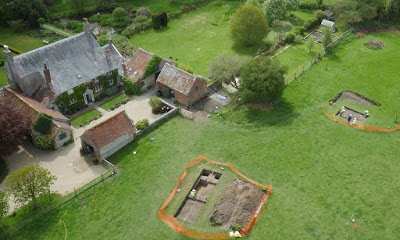ONE of the largest Roman villas ever discovered in Britain may have been built to accommodate Emperor Hadrian … and Antinous … on trips to oversee construction of Hadrian's Wall.
The ruins of the sprawling villa have been found buried under a home in Wiltshire. Rug designer Luke Irwin was laying an electricity cable in a barn on his property last year when he struck upon a mosaic under the ground.
"I sent a photograph to the council and within 24 hours they were here with archaeologists to see what we'd found," he said.
Experts from Historic England and Salisbury Museum began excavation of the site and realised the mosaic formed part of the floor of a much larger Roman building.
A grand villa to be precise, which was built sometime between the time of Hadrian and 220 AD and could have been home to a visiting Roman emperor.
Archaeologists described it as the most significant discovery of its kind in more than a decade.
Archaeologists described it as the most significant discovery of its kind in more than a decade.
Dr David Roberts, an archaeologist from Historic England, helped work on the excavation.
He said: "The site has not been touched since its collapse 1,400 years ago and so it's of extreme importance.
"The large scale and complexity of the site present a unique opportunity to understand Roman and post-Roman Britain."
From their research, archaeologists believe the villa had three-storey structures similar to those found at another Roman villa in Chedworth, Gloucester.
This means there is reason to believe the villa belonged to a family of extraordinary wealth and importance.
Experts also found hundreds of discarded oyster shells, a perfectly preserved Roman well and the stone coffin of a Roman child.
Amazingly, the coffin had gone unnoticed and held flowers until it was identified.
"It's unbelievable," Mr Irwin said. "The thought of the footsteps we are following in. I have always been fascinated by history ever since I went to Pompeii as a child.
"But to find it 20 yards from your own front door - and then the 20 billion to one shot that you design luxury rugs for the Roman aristocrats of today. It's mind blowing."
The site in Warminster has now been scheduled to protect and preserve it, but for the time being there will be no more research until archaeologists get more funding and technology improves.
Roman Emperors in Britain:
:: Rome's most famous ruler, though not technically an emperor, Julius Caesar made two expeditions to Britain, in 55 and 56BC, but failed to gain much of a foothold. His adventures are recounted in varying levels of seriousness in his own De Bello Gallico and in comic book classic Asterix In Britain.
:: Hadrian (117-138) visited Britain in response to a major rebellion, ordering the building of Hadrian's Wall, "to separate Romans from barbarians". Much of the wall remains intact some 2,000 years later.
:: Septimius Severus (193-211) seized power in the bloody "Year of the Five Emperors" (think a particularly cast-depleting episode of Game Of Thrones). After a series of victories over Rome's enemies and his own rivals, he got bogged down fighting the Caledonians in what is now Scotland, and died in York.
:: Septimius' son Caracalla (211-217) was with him in York when he died. One of Rome's cruellest emperors, Caracalla got round the problem of having to share power with his brother Geta by simply having him murdered in front of their mother. He was himself assassinated a few years later while relieving himself by the road in Turkey.




No comments:
Post a Comment